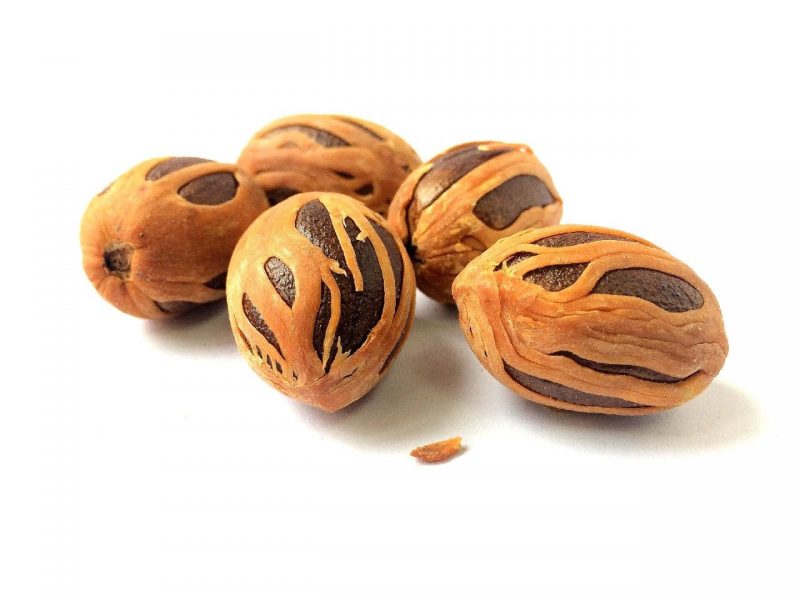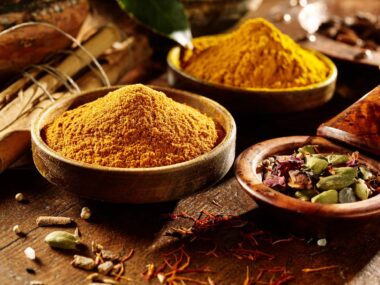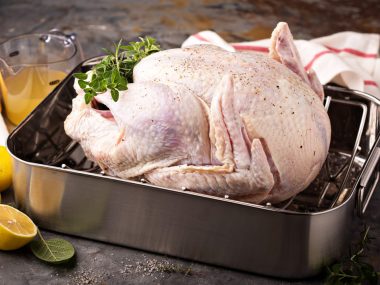Nutmeg and mace originate from the same tree, known as the nutmeg tree. This tree is native to the Banda Islands. However, you can also find it heavily cultivated in the Caribbean.
Specifically, you can find it on the islands of Jamaica and Grenada. The fruits of this tree have a hard pit in the center. That’s the nutmeg. On the top of those seeds is something that appears like melted wax and that’s often referred to as aril. That’s the mace. They share similarities in origin.
But what about usage and taste? One of the differences you will notice when you purchase these spices is the price. Each nutmeg plat provides a lot more nutmeg than it does mace.
The supply of nutmeg is greater. Therefore, its price is lower. Another big difference is popularity. Mace isn’t as popular as nutmeg. Nutmeg is essential in different recipes.
You will notice more recipes that mention nutmeg as a vital ingredient which isn’t the case with mace. Mace has a more intense flavor than nutmeg. It’s spicier and resembles black pepper.
Although it’s stronger, it also loses its flavor quicker than nutmeg. It’s recommended to use fresh mace instead of using a product that’s been sitting in your kitchen cabinet for some time.
While you should purchase all of your spices whole if you have the change, mace is one product that you should try to avoid ground form because of how fast it loses its flavor.
Unless you want to utilize a whole container in a short period, instead of ground, purchase whole blades of mace. You can keep whole nutmeg seeds for days under the proper terms.
Can You Substitute Nutmeg for Mace?
Both mace and nutmeg are parts of the same seed. And have much the same flavor profiles. Therefore, you can often utilize them interchangeably.
Mace can perform as a nutmeg substitute. However, keep in mind that it’s stronger. Utilize half as much mace as nutmeg when substituting nutmeg in a recipe.
And double nutmeg when substituting mace. Dilute or add to taste when needed. However, don’t forget that mace’s taste can dim quickly once you display it to heat.
Add it to the end of cooking time to stop this. If you’re utilizing whole mace blades, remove them before serving.
Note that while the spices can be utilized in place of each other to get similar flavors, mace will boost the cost of your dish.
Is Mace the Same as Nutmeg?
Mace and nutmeg come from the same tree but they’re not the same spices.
Mace has a stronger flavor while nutmeg is cheaper because each nutmeg plat gives a lot more nutmeg than it does mace. Also, mace is less popular than nutmeg.
Usual uses for mace include mixes of the regular Indian spice mix otherwise called gram masala. You can see it in a spice blend from Morocco known as ras el hanout as well.
Mace is a usual component in certain rice dishes and different soups.
However, nutmeg’s list of uses is longer than that of mace. You can notice it in different recipes such as Italian meatballs, French Bechamel sauce, Scottish haggis, and so on.
You can also find it in some English mulled wines and Japanese curry powders.
What Does Mace Taste Like?
Mace and nutmeg are siblings. They come from the same tree. However, they’re not the same herbs. If you want something stronger, use mace. It has a stronger flavor.
And resembles black pepper. It has some of the black pepper’s qualities. As I already said, they originate from the same tree known as Myristica fragrans and they’re similar.
The nutmeg is the oval-shaped pit, while the mace is the red bright webbing that borders the shell of the pit. The mace is detached, dried, and then ground into a powder that gets a reddish color.
The nutmeg can either be dried and grated fresh. Or dried and left complete and packed for grating. The flavor between mace and nutmeg is a bit different. Mace is spicier and stronger.
It’s similar to the mix of pepper and cinnamon. Nutmeg, on the other hand, can be described as weaker. It has a similar sweetness to cinnamon but stronger.
Both herbs include some of the same oils that cloves and flavor pepper. However, although they have similar uses, people rarely use them in recipes together.
I think that nutmeg has a sweeter and more delicate taste and smell than mace but you determine which one you prefer. Nutmeg is usually utilized in baking recipes.
You can notice it in different recipes for cookies, cakes, and aromatic dishes such as sausages, meats, preserves, fruits, soups, and stews. You can also find it in eggnog.
This famous holiday drink wouldn’t taste the same without a bit of nutmeg.
What Herbs Work With Mace and Nutmeg?
In terms of utilizing nutmeg with other herbs, it works well with vanilla, thyme, sugar, pepper, ginger, cumin, cranberries, coriander, cloves, cinnamon, and cardamon.
You can utilize nutmeg in aromatic dishes like eggs, cabbage, beans, asparagus, onion, fish, carrots, veal, potatoes, lamb, pumpkin, seafood chowders, yams, sausage, and coffee beverages.
Mace is usually utilized in baking. And has been the main flavor in doughnuts for a long time. It’s often utilized in cookies, cakes, and aromatic dishes, just like the nutmeg.
Mace works well with cloves, cinnamon, sugar, ginger, cranberries, cumin, vanilla. Additionally, it tastes great in pumpkin, yams, eggs, potatoes, veal, sausage, and stuffings.
Honor the taste of fall herbs with mace and nutmeg and try experimenting with both herbs. Share your thoughts on both herbs in the comments below. I find it fun and interesting to learn about which one is preferred by people.
For best nutmeg taste, buy complete nutmegs and grate them by utilizing the tiniest grater holes simply before applying them to your recipe.
A complete nutmeg yields at least 2 to 3 teaspoons of grated spice. And the best taste of the nutmeg oil will evaporate fast. Therefore, utilize it quickly!
You can purchase nutmeg ground and while. However, because taste evaporates fast, most people want to buy nutmeg whole and grate it as required.
Mace has a sharper, stronger nutmeg taste.
Therefore, it’s utilized in lesser amounts, if nutmeg can’t be found. You can buy mace in whole pieces called blades but it’s also available ground.
Fun Facts About Mace and Nutmeg
Fact #1:
Nutmeg isn’t a nut.
Fact #2:
Nutmeg was so popular that people carried or wore a nutmeg in a tiny grate-equipped box. This allowed them to shave a sprinkle of the herb on their everyday dishes.
Fact #3:
It takes 5 years for nutmeg trees to flower. Complete bearing happens after 15 years and the trees keep to bear fruit for about 5 decades. A mature tree that gets about 40 feet in height provides up to 2,000 nutmegs annually.
Final Words
Mace and nutmeg are plant products. Nutmeg is dried, shelled seed of the tree Myristica fragrans while mace is the net-like dried covering of the shell of the seed.
Mace and nutmeg might also kill fungi and bacteria. You can also find them as a fragrance in cosmetics and soaps. Hopefully, you learned the difference between mace vs nutmeg.
Have you ever used either nutmeg or mace? Which one do you prefer? Feel free to share your thoughts in the comments below!


